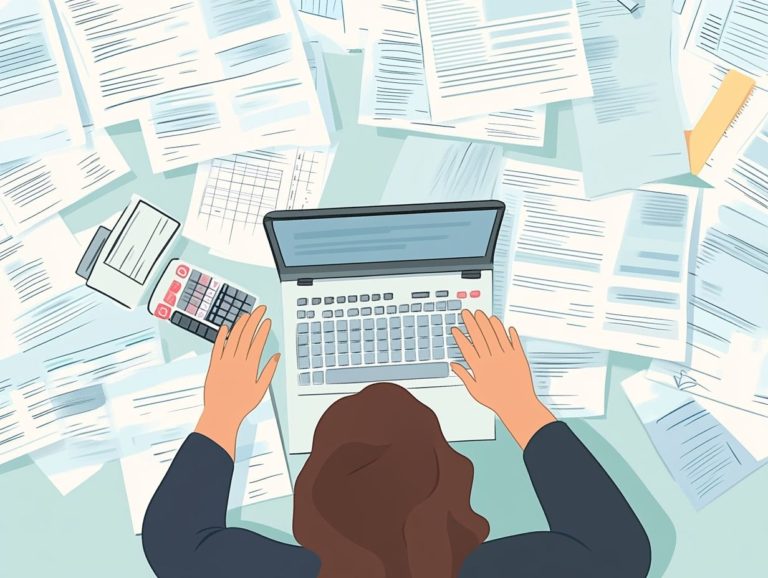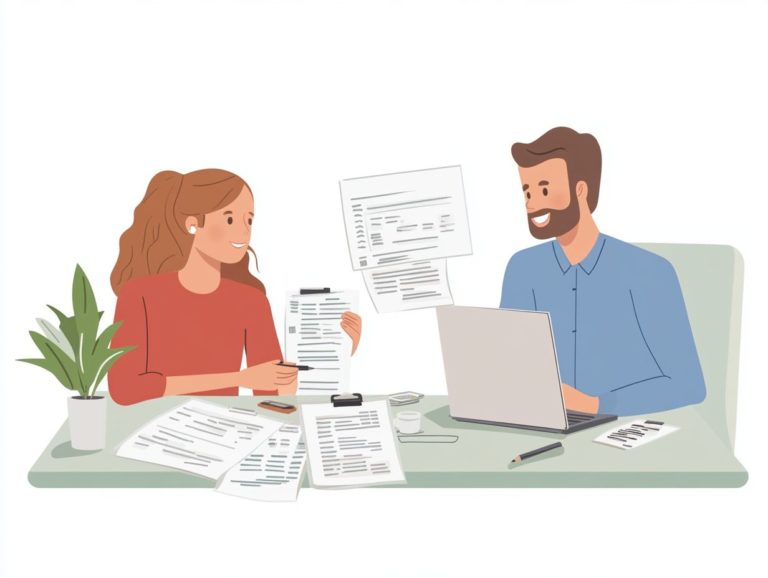Navigating Quarterly Taxes as a Freelancer
Quarterly taxes can seem overwhelming for freelancers and self-employed individuals. However, understanding the intricacies of this process is vital for your financial stability and legal compliance.
This guide provides all the essential information you need. It defines quarterly taxes, identifies who is obligated to pay them, and explains how to calculate your estimated tax payments and track significant deadlines.
It also offers practical strategies for managing your tax obligations, such as the home office deduction, and helps you avoid common pitfalls. By the end of this journey, you will be ready to tackle your taxes with confidence, including understanding your tax rates and potential tax credits.
Contents
- Key Takeaways:
- Understanding Quarterly Taxes
- Who Needs to Pay Quarterly Taxes?
- Calculating Quarterly Tax Payments
- Quarterly Tax Deadlines
- Tips for Managing Quarterly Taxes as a Freelancer
- Avoiding Penalties and Audits
- Frequently Asked Questions
- Quarterly Taxes: Who Needs to Pay and Why?
- Do I Need to Pay Quarterly Taxes if I Have a Full-Time Job?
- How Do I Calculate How Much I Owe in Quarterly Taxes?
- When Are Quarterly Taxes Due and How Do I Make a Payment?
- What Happens If I Don’t Pay Quarterly Taxes?
- Can I Make Adjustments to My Quarterly Tax Payments Throughout the Year?
Key Takeaways:

- Quarterly taxes are required for freelancers who expect to owe more than $1,000 in taxes annually.
- Organizing and tracking income and business expenses is crucial for accurate quarterly tax estimates.
- Missing quarterly tax deadlines can result in penalties and interest charges.
Understanding Quarterly Taxes
Grasping the intricacies of quarterly taxes is essential for self-employed individuals and those in the gig economy. It directly influences your tax obligations and ensures compliance with IRS regulations.
This process involves making estimated tax payments four times a year, reflecting your income sources, such as freelance work, self-employment, or other business structures. By understanding these payments and following tax planning tips for new freelancers, you can manage your tax liabilities more effectively, avoiding underpayment penalties and fostering financial stability throughout the year while contributing to your retirement savings.
This proactive approach not only simplifies your annual return process but also enhances your overall financial well-being.
What are Quarterly Taxes?
Quarterly taxes refer to the estimated tax payments you, as a self-employed individual or freelancer, must submit to the IRS every quarter. These payments are necessary to cover your income tax, Medicare tax, and self-employment tax.
Making these payments is crucial for managing your tax liabilities throughout the year, sparing you from a potentially overwhelming lump sum during tax season. The primary aim of these estimated payments is to ensure the IRS receives tax revenue in a timely manner, allowing you to distribute your tax burden more evenly. For freelancers, knowing how to save for taxes is essential in this process.
You can utilize Form 1040-ES as a framework for calculating these anticipated payments based on your projected income and applicable deductions. It’s essential to maintain accurate records of your income and expenses. This not only helps you determine the proper estimates but also ensures compliance and simplifies your year-end tax filing. For more specific advice, check out these tax tips for freelancers in the gig economy.
Who Needs to Pay Quarterly Taxes?
If you’re self-employed, a freelancer, or earning income through different business structures, you likely need to pay quarterly taxes to fulfill your obligations as specified by the IRS, especially if your self-employment income surpasses a certain threshold.
It’s essential to stay ahead of these requirements to ensure compliance and avoid any unexpected surprises come tax season.
Determining Your Tax Obligations
Determining your tax obligations requires a careful analysis of your estimated taxes, particularly regarding various income sources. This is especially crucial for self-employed individuals, as you must account for self-employment income to maintain compliance with IRS requirements and avoid underpayment penalties.
By thoroughly evaluating all your income streams, including freelance gigs, side projects, and income from Form 1099, you can gain clarity on your financial responsibilities. Keeping detailed records of your earnings is essential; it will facilitate accurate reporting to the tax authorities. Additionally, understanding how to handle tax audits as a freelancer can be invaluable. Seeking guidance from a qualified tax professional can provide you with tailored advice, helping you navigate any complexities that may arise.
Numerous online resources are available to enhance your understanding of tax calculations. For freelancers, knowing what to do if you owe back taxes is crucial. These tools and tutorials can simplify the process, enabling you to take charge of your financial future with confidence.
Calculating Quarterly Tax Payments

Calculating quarterly tax payments is an essential skill for self-employed individuals. It allows you to accurately estimate your tax obligations based on your net profit what you earn after subtracting your business costs and business expenses. This ensures that you remain compliant with IRS regulations.
Mastering this process helps you avoid potential penalties and enables you to manage your finances with confidence and precision.
How to Estimate and Pay Your Taxes
Estimating and paying your taxes can be a breeze when you break the process down into manageable steps. This approach helps self-employed individuals like you make your estimated tax payments correctly and on time.
The first step is to gather all relevant income and expense data. This allows for a thorough evaluation of your financial status. Track income from various sources and document deductible expenses that can lower your taxable income. Additionally, it’s wise to review freelancer tax tips for first-time filers to ensure you’re maximizing your deductions and minimizing your tax liabilities.
Once you’ve organized this data, turn to reliable IRS resources, such as IRS.gov/payments, to calculate your expected tax liabilities with ease. Staying vigilant about IRS deadlines is essential to avoid late fees or penalties, giving you peace of mind as tax time approaches.
By following these steps, you can navigate your tax responsibilities with greater confidence and clarity.
Quarterly Tax Deadlines
Quarterly tax deadlines hold immense importance for self-employed individuals. Missing these dates can lead to substantial penalties and may impact your overall tax responsibilities to the IRS.
It’s essential to stay vigilant and ensure you meet these deadlines to maintain your financial well-being.
Important Dates to Remember
Important dates for your quarterly taxes are vital, particularly the deadlines for submitting your estimated tax payments to the IRS. These deadlines occur four times a year.
Typically, these critical dates fall on April 15, June 15, September 15, and January 15 of the following year. Don t miss these critical deadlines plan ahead to avoid penalties!
Set up reminders or use online calendar tools to manage deadlines effectively. By taking proactive steps, you can avoid complications and streamline your tax-paying process, especially when you understand what to know about sales tax as a freelancer.
Tips for Managing Quarterly Taxes as a Freelancer
Managing your quarterly taxes as a freelancer demands effective organizational strategies and meticulous planning. This approach ensures timely payments and compliance with IRS rules, significantly alleviating the stress that often accompanies tax season.
Organizational Strategies and Tools

Utilizing effective organizational strategies and tools can be a game-changer for freelancers when it comes to managing tax records. This ensures you can effortlessly access the necessary information for quarterly tax payments and your annual return.
By adopting practices such as maintaining detailed digital records and meticulously categorizing business expenses, you can streamline your tax preparation process. Accounting software like QuickBooks or FreshBooks is essential in tracking your income and expenses. Additionally, understanding how to estimate your taxes as a freelancer allows you to generate reports that offer clear insights into your financial health.
Tools like Expensify or Shoeboxed can help you organize receipts and monitor cash payments made throughout the year. By leveraging these resources, you enhance your efficiency and reduce the stress that often accompanies tax season as a freelancer.
Avoiding Penalties and Audits
For self-employed individuals, steering clear of penalties and audits is paramount. Common missteps can have serious repercussions, such as underpayment penalties and heightened scrutiny from the IRS.
Staying vigilant and informed is key to safeguarding your financial well-being.
Start organizing your records today to simplify your tax season!
Common Mistakes and How to Avoid Them
Self-employed individuals often stumble into common pitfalls that can threaten their financial stability and attract unwanted attention from the IRS. Understanding how to avoid these mistakes is crucial.
Among the most frequent missteps are failing to make timely quarterly tax payments and underestimating taxable income. Both can lead to penalties and unexpected tax burdens that no one wants to deal with.
Delaying payments can exacerbate the situation, as interest and penalties pile up. Meanwhile, miscalculating income could leave you facing a larger tax bill than you ever anticipated.
To mitigate these issues, it s essential to keep meticulous records throughout the year. Consider setting aside a percentage of your earnings specifically for taxes, including contributions to a Traditional IRA or Roth IRA.
A qualified tax professional can provide personalized insights, helping you craft a proactive strategy tailored to your unique financial circumstances. This approach makes tax management easier. It also helps you feel more confident in meeting your obligations and planning for retirement.
Frequently Asked Questions
Quarterly Taxes: Who Needs to Pay and Why?
Quarterly taxes are payments made to the government every three months rather than once a year. Freelancers and self-employed individuals must pay quarterly taxes if they expect to owe $1,000 or more in taxes for the year. These tax obligations are crucial for managing freelance income and tax liabilities.
Do I Need to Pay Quarterly Taxes if I Have a Full-Time Job?

If you have a full-time job and also work as a freelancer, you may still need to pay quarterly taxes. This depends on your freelance income and whether your employer withholds enough taxes from your paycheck to cover your total tax liability.
How Do I Calculate How Much I Owe in Quarterly Taxes?
The best way to calculate your quarterly tax payment is to use the Estimated Tax Worksheet provided by the IRS. This worksheet accounts for your expected income, deductions, and credits to determine the amount you should pay each quarter.
When Are Quarterly Taxes Due and How Do I Make a Payment?
Quarterly taxes are due on the 15th of April, June, September, and January of the following year. You can make a payment electronically through the IRS website or by mailing a check with your payment voucher.
What Happens If I Don’t Pay Quarterly Taxes?
If you don’t pay your quarterly taxes on time, you may be subject to penalties and interest on the amount you owe. Stay ahead of your quarterly tax payments to avoid unnecessary penalties!
Can I Make Adjustments to My Quarterly Tax Payments Throughout the Year?
Yes, if your income or expenses change significantly during the year, you can make adjustments to your quarterly tax payments. This can be done by using the Estimated Tax Worksheet or by filling out Form 1040-ES and mailing it to the IRS.






